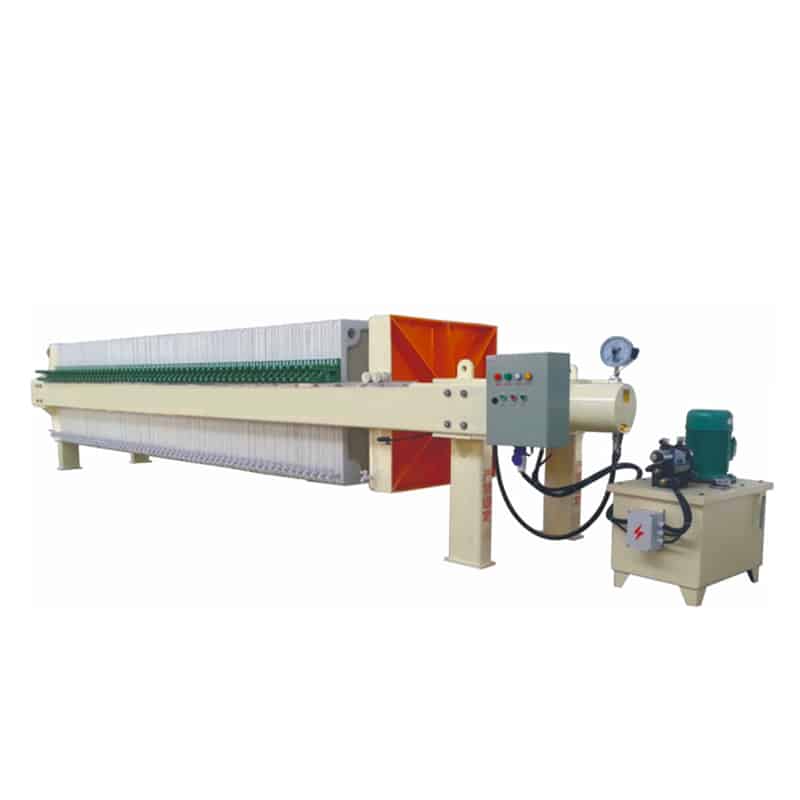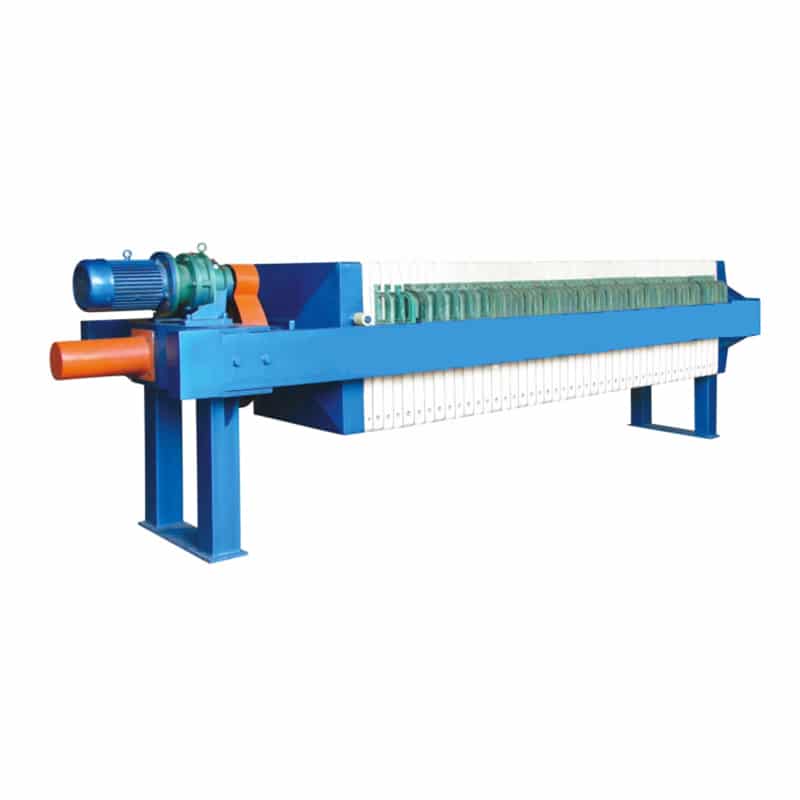Filter press technology plays a vital role in industry, especially in the field of solid-liquid separation. As one of the key equipment, recessed plate filter presses are widely used in a variety of industries, including chemical, pharmaceutical, food and beverage, and environmental engineering.
Introduction of the recessed plate filter press
The basic principle of the recessed plate filter press is to utilize the space between the filter plate and the filter frame to form a filter chamber, and by applying pressure to the mixture, the liquid is filtered through the filter cloth or the filter paper, while the solid particles are retained in the filter cloth, forming a filter cake. In this way, the purpose of solid-liquid separation is realized.
Recessed plate filter presses usually consist of a filter plate, a filter frame, and a pressing device. The filter plate has grooves that can be used to install filter cloth or paper and can be pressed under a certain pressure to improve filtration efficiency. The frame is a frame around the plate to hold the plate in place and form the filter chamber.
Working process of the concave plate filter press
- Slurry feed: First, the slurry or mixture to be treated is injected through the feed pipe into the inlet of the filter press. The slurry contains solid particles and liquid components.
- Cake formation: After the slurry enters the filter press, under pressure, the liquid components are filtered out through the filter cloth or paper, while the solid particles are retained on the filter cloth to form a cake. With the continuous feeding of the slurry and the increase of pressure, the thickness of the filter cake gradually increases.
- Filtrate discharge: The clear filtrate enters the retention chamber through the filter cloth and is discharged through the discharge pipe. Typically, the filtrate is cascaded through multiple chambers of the filter press to ensure that the final liquid is clear.
- Cake handling: Once the cake reaches a certain thickness, the feed to the filter press is stopped and the cake can be removed from the press using an extraction device after a certain period of curing and compaction. The filter cake can usually be used for reprocessing or disposal, such as incineration, recycling, or disposal of waste.
Advantages of the recessed plate filter press
- High efficiency: The recessed plate filter press adopts a multi-layer filter plate and filter cloth structure, which can realize efficient solid-liquid separation, fast cake formation, and clear filtrate.
- Easy to operate: The operation of the filter press is relatively simple, only need to set the operating parameters, start the equipment can run automatically. The operator usually only needs to monitor the running status of the equipment and does not need too much technical training.
- Low maintenance cost: The maintenance cost of the recessed plate filter press is relatively low because of its simple structure, few parts, and components, which are not easy to be damaged and have a long maintenance cycle. Usually only needs regular cleaning and lubrication of key components to ensure the normal operation of the equipment.
- Wide range of applications: The recessed plate filter press is suitable for a variety of solid-liquid separation scenarios, including chemical, pharmaceutical, food processing, environmental protection, and other industries. Different models and specifications of the filter press can be customized and adjusted according to different process requirements, with strong adaptability and flexibility.
- Energy saving: The recessed plate filter press is usually driven by hydraulic or mechanical pressure, which consumes less energy and saves energy compared with other filter presses.
- Friendly operating environment: the noise generated by the recessed plate filter press in the process of operation is low, and the wastewater and waste residue discharged can meet the environmental standards after treatment, in line with modern environmental requirements.
Areas of application for recessed plate filter presses
Recessed plate filter presses are widely used in various industries, and they play a key role in solid-liquid separation and are mainly used in the following fields:
Mining: In the field of mining, recessed plate filter presses are commonly used to extract useful components from metal ores, such as extracting solid particles from metal ores such as gold, silver, and copper, and separating them from water. The solid particles in the slurry are separated from the water by the filter press, thus realizing the concentration and purification of the ore.
Chemical: In chemical production, recessed plate filter presses are widely used in the separation, filtration, and recovery of chemical raw materials. For example, in the organic synthesis process, solid particles and solvents in the reaction mixture need to be separated, and the recessed plate filter press can efficiently accomplish this task.
Food processing: In the food processing industry, recessed-plate filter presses are commonly used for clarification and filtration of liquid foodstuffs such as fruit juices, wines, and beverages. Solid particles, suspended solids, and impurities in the liquid can be removed by the filter press, thus improving the quality and purity of the food.
Wastewater treatment: Recessed plate filter presses are used for solid-liquid separation and sludge dewatering in wastewater treatment processes. Through the filter press, solid particles and suspended solids in wastewater can be separated, thus purifying the water quality, meeting the discharge standard, and protecting the environment.
Environmental protection: Recessed plate filter press is also widely used in environmental protection projects, such as the treatment of industrial wastewater, municipal wastewater, solid waste, and so on. The useful substances in the waste can be recycled and utilized through the filter press, and at the same time, the volume of the waste can be reduced to reduce environmental pollution.
Difference between plate and frame filter press and recessed plate filter press
There are some obvious differences between plate and frame filter presses and recessed plate filter presses in terms of structure and working principle:
Structural difference:
- Plate and frame filter press: its filter plate and frame are separated, and the filter media forms a filter cake on the plate, which is then compacted. After the cake is formed, the pressure is applied to the filter material through the filter plate and the filter frame.
- Recessed Plate Filter Press: The filter plate of the recessed plate filter press has a grooved or recessed structure, which forms a filtrate channel on the surface of the plate while forming the filter cake.


The cake is discharged in this manner:
- Plate and frame filter press: Cake is discharged manually and usually requires downtime.
- Recessed plate filter press: after the formation of the filter cake, the filtrate is discharged through the grooves, and the filter cake can be continuously discharged during operation.
Scope of application:
- Plate and frame filter press: suitable for processing thin suspensions, which require frequent downtime to clean up the filter cake during processing.
- Recessed plate filter press: suitable for processing concentrated suspension, the cake can be discharged continuously during the process, which improves production efficiency.
Summary
In short, the requirements for solid-liquid separation in industrial production can be met using recessed plate filter presses, which quickly and efficiently separate solid particles from liquids in suspension to obtain a dry cake and a clear filtrate.
KUOSI offers a wide range of filter presses, as well as sludge dryers, dosing systems, blowers, disinfection systems, and wastewater screens. If in doubt, come and consult us.
